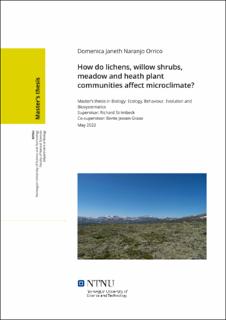| dc.description.abstract | Increases in earth's surface temperature because of climate change in the last decades have
already shown consequences in different ecosystems and in different taxonomic groups. Alpine
environments are among the most threatened by the effects of climate change because the
organisms that live there are conditioned to low temperatures. Several changes in alpine
communities have already been observed, however, shrub encroachment is one of the most
evident. This encroachment affects especially smaller organisms that are not good competitors,
such as cryptograms. Leading to changes in the community that have shown to affect macro and
microclimate. The most common way of reporting temperature is the mean annual
temperature which does not reflect what plants and lichens are experiencing. Microclimate is the
actual temperature that the organism is experiencing. Studies have shown that microclimate
can impact community structure and its dynamics over time. Moreover, community structure
can affect the microclimate via organisms’ interactions. Little is known about how functional
groups of established plants affect the microclimate. In this project, we study and describe how
different community types such as willow shrubs, meadow, heath, and lichen ridgetop, and
environmental variables affect the microclimate through the use of thermal imaging. During
June-July 2020 thermo-photographs were taken and environmental variables were measured in
a heath, a lichen ridgetop, a meadow, and a willow dominated community in Dovrefjell. It was
found that all the plots presented a higher temperature than that recorded for air temperature.
The models showed that wind speed decreased decoupling and light intensity increased
decoupling from air temperature. The willow, a community dominated by deciduous shrubs, and
the meadow (dominated by grasses and forbs) were more coupled to air temperature while the
heath (dominated by dwarf evergreen shrubs) and the lichen ridgetop (dominated by lichens)
were more decoupled from air temperature. Deciduous shrubs presented the lowest and lichens
presented the highest surface temperatures. No significant differences in surface temperature
were found for lichen species, colouration nor growth form. | |
